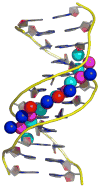Poly(dA:dT) tracts: major determinants of nucleosome organization
- PMID: 19208466
- PMCID: PMC2673466
- DOI: 10.1016/j.sbi.2009.01.004
Poly(dA:dT) tracts: major determinants of nucleosome organization
Abstract
Homopolymeric stretches of deoxyadenosine nucleotides (A's) on one strand of double-stranded DNA, referred to as poly(dA:dT) tracts or A-tracts, are overabundant in eukaryotic genomes. They have unusual structural, dynamic, and mechanical properties, and may resist sharp bending. Such unusual material properties, together with their overabundance in eukaryotes, raised the possibility that poly(dA:dT) tracts might function in eukaryotes to influence the organization of nucleosomes at many genomic regions. Recent genome-wide studies strongly confirm these ideas and suggest that these tracts play major roles in chromatin organization and genome function. Here we review what is known about poly(dA:dT) tracts and how they work.
Figures



References
-
- Struhl K. Naturally occurring poly(dA-dT) sequences are upstream promoter elements for constitutive transcription in yeast. Proc Natl Acad Sci USA. 1985;82:8419–8423. This paper was the first to report that poly(dA:dT) elements in a gene’s promoter facilitate transcription in vivo, and the first to connect this observation with a possible mechanism, suggesting that poly(dA:dT) elements could act by depleting repressive nucleosomes from the promoter. - PMC - PubMed
-
- Iyer V, Struhl K. Poly(dA:dT), a ubiquitous promoter element that stimulates transcription via its intrinsic DNA structure. EMBO J. 1995;14:2570–2579. This paper was the first to provide concrete evidence in support of the model in which poly(dA:dT) elements act by depleting repressive nucleosomes from a gene’s promoter, thereby effectively enhancing transcription. - PMC - PubMed
-
- Moreira JM, Remacle JE, Kielland-Brandt MC, Holmberg S. Datin, a yeast poly(dA:dT)-binding protein, behaves as an activator of the wild-type ILV1 promoter and interacts synergistically with Reb1p. Mol Gen Genet. 1998;258:95–103. - PubMed
Publication types
MeSH terms
Substances
Grants and funding
LinkOut - more resources
Full Text Sources
Other Literature Sources

